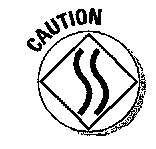
Before you rush out and buy a set of tires, you have a couple of other things to consider. Tire wear is affected by a number of factors besides construction: the condition of the vehicle’s brake system and suspension system; inflation and alignment; driving and braking techniques; driving at high speeds, which raises tire temperatures and causes them to wear prematurely; how great a load you carry; road conditions; and climate.
Here are some of the types of tires that you may want to consider:
Basic all-season
tires are standard equipment on most cars. The speed rating (see the “Speed rating” section earlier in the chapter) is usually S or T. If “M+S” (mud and snow) is printed on the sidewall, the tire will per form well in inclement weather without the need for snow tires.
Touring tires
are generally more expensive than basic all-season tires. Whether they’re worth the money depends on the individual product. These tires usually are speed-rated S or T.
Performance tires
are designed for people who drive “aggressively.” They perform better in terms of braking and cornering but are usually noisier and wear out more quickly. They are usually speed-rated H and have a wide, squatty profile.
Ultra-high performance tires
have both the positive and the negative aspects of performance tires to a greater degree: They go faster, brake and handle better in wet and dry conditions, but ride less comfortably and wear out even faster. They are even wider and are usually speed-rated V or Z.
Light-truck tires
are intended for use on light trucks and SUVs. They come in a variety of styles designed for normal conditions, driving on- or off-road, or both. The thicker treads on the off-road variety offer better traction on unpaved surfaces. Light-truck tires also vary for carrying normal, heavy, and extra-heavy loads.
Snow tires
may be better than all-season tires for driving in mountainous areas with heavy snowfall, but they’re noisy and don’t handle as well on dry roads, so use them only when necessary.
“Run-flat” tires
can be driven on without any air pressure inside the tire. Run-flat equipped vehicles may not even come with a jack or spare tire. (If you’re driving a 1997 or newer Chevrolet Corvette or a similarly equipped new vehicle, you probably have this special type of radial tire.) The side-walls have specially compounded inserts that prevent the tire from caving in when the tire loses air pressure. You can drive some run-flat tires up to 50 mph for 50 miles or more without further damaging the tire.
Running on a run-flat at high speeds for a long period can damage them, so car manufacturers incorporate a warning system. For example, the Corvette has tire pressure sensors at each wheel so that the driver can be warned when one or more tires are flat. Because the driver can’t feel any difference when a run-flat goes flat, a warning light illuminates on the instrument panel, signaling the driver to limit his or her driving speed and distance to avoid further damage to the tire or wheel.
Before making a decision about a particular type of tire, take a close look at your driving habits:
Are you hard on tires?
If you tend to “burn rubber” when cornering, starting, and stopping, you know where that rubber comes from. A pair of cheaply made tires will wear out quickly, so buy the best quality you can afford.
Do you drive a great deal and do most of your driving on high-speed freeways?
A tire with a harder surface will take longer to wear out under these conditions.
Do you drive a lot on unpaved rocky roads, carry heavy loads, or leave your car in the hot sun for long hours?
You’ll need higher-quality tires that have the stamina to endure these challenges.
What’s the weather like in your area?
Today, front-wheel drive vehicles with high-tech all-season tires get better traction than the old snow tires, which you had to replace when warm weather set in. However, if you drive under
extreme conditions, you may want to check out tires designed for them: If it rains a lot, look for rain tires with super-wide grooves in the treads. For places with lots of snow or icy hills, look for “M+S” (mud and snow) on the sidewall.
Do you drive mostly in local stop-and-go traffic, with many turns?
Softer tires with wider treads will suit you best.
How long do you intend to keep your car?
Putting a pair of expensive tires on a vehicle that you intend to get rid of in 10,000 or 20,000 miles is foolish. Oh, it’s possible to put well over 100,000 miles on a vehicle — especially if you maintain it properly — but if you have a relatively old vehicle with many miles on it already, and you don’t intend to keep it very long, I wouldn’t buy a pair of expensive mega-mile tires for it. Your car may surprise you and outlive its tires, but chances are that it won’t. Similarly, it’s foolish to put high-performance tires on a vehicle that will be driven mostly at normal speeds in city and highway traffic.
On the other hand, if you intend to keep your vehicle for a few years, you’ll save money in the long run by opting for more expensive, longer-lasting tires than “cheapos” or tires rated for less than 40,000 miles. Cheap tires wear out more quickly and cost more in the long run if you figure in the cost of buying, mounting, and balancing that second set. What’s more, if you suffer a blowout or your tires fail to grip the road, you’ll pay a great deal more if your vehicle — or you — is injured.
If you drive only a couple of thousand miles a year, don’t expect a pair of 40,000-mile radials to last forever. Rubber treads tend to rot eventually because of the ozone in the air, which causes cracks and hard spots in the sidewalls — a condition called ozone checking. For this reason, if you’ve used your tires for more than 40,000 miles, even if the treads are in good shape, have the tires checked to make sure that deteriorating rubber hasn’t made them prone to blowouts and leaks.
In addition to knowing which kind of tire is best for your car and understanding the tire codes (explained in the section called “The Secrets on Your Sidewalls, Revealed!”), keep the following tips in mind when you shop for tires:


You can find the proper tire size for your car in the owner’s manual or on a sticker affixed to the vehicle. If neither exists, ask your dealer.
Although you should never buy tires that are smaller than those specified for your vehicle, you can buy tires a size or two larger (if the car’s wheel clearance allows it) for better handling or load-carrying ability. However, you should buy these larger tires in pairs and place them on the same axle. Ask your mechanic or a reputable tire or auto dealer for advice about the proper size range for your vehicle. For more advice, see “Tips for Buying Tires,” later in this chapter.
Never use two different-sized tires on the same axle.
If you’re replacing just one or two tires, put the new ones on the front for better cornering control and braking (because weight transfers to the front tires when you brake).
If you still have bias-ply or bias-belted tires on your car, you must replace all of them at the same time with radials when they wear out. You can’t mix different kinds of tires on the same vehicle; you should have the same type on all four wheels. The ride is so different that radial tires would throw your car out of alignment if you tried them in combination with the old-style tires.
Remember that you have to “break in” new tires, so don’t drive faster than 60 mph for the first 50 miles on a new tire or spare.
Store tires that you aren’t using in the dark, away from extreme heat and electric motors that create ozone.
Retreads: Bargains or blowouts?
Millions of tires are discarded every year, and an entire industry has developed to put them back on the road by replacing the worn tread areas with new ones. The retreading process involves grinding the tread off an otherwise sound old tire and winding a strand of uncured rubber around the tire. Then the tire is placed in a mold, where the rubber is cured under heat and pressure and the tread itself is shaped. Finally, the tire is painted.
The largest number of these “retreads” are intended for government and industrial fleets of vehicles — such as postal and fire trucks and buses — but they can be purchased for private vehicles as well. For many years, retreads had a reputation of being unreliable, and most consumers assumed that the strips of tread they saw littering the highways came from retreaded
tires that had disintegrated on the road. But today, advances in retreading have raised their quality, and the industry’s Tire Retread Information Bureau claims that retreads have the same 3 percent failure rate as new tires. So if you’re interested in recycling, you may be motivated to buy retreads in order to reduce the number of tires heading for landfills.
Unfortunately, the number of retread manufacturers has diminished. Of 12,000 tire retreading plants during World War II, only about 1,400 are left today. As a result, retreads may be difficult to find. It’s hard to tell the good stuff from the bad, so if you buy retreads, make sure that they’re from a well-known, major manufacturer, such as Fargo, which claims a failure rate of only 1.5 percent.

